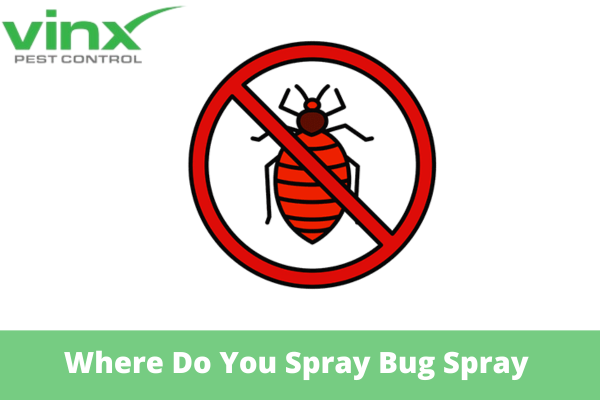Bug spray or insecticides can be a simple approach when dealing with annoying pests and insects in our living areas. However, these products must be used carefully and correctly to maximize their benefits while limiting potential hazards. In this blog, we’ll guide you on the best locations to spray insecticide and how to spray for bugs inside house to achieve optimal effectiveness. We’ll also cover important aspects such as safety precautions, occupancy considerations, and the duration of effectiveness after spraying. Get ready to bid farewell to those unwanted house guests!

Suggested Areas To Spray Bug Spray
It is critical to target locations where insects are likely to hide, enter, or travel when using bug spray in a room. You can increase the efficiency of the bug spray by concentrating on these locations. When spraying insect spray in a room, keep the following areas in mind:
Baseboards: Spray along the baseboards or skirting boards, as these places are frequently used as insect hideouts.
Cracks and Crevices: Insects can enter the room through cracks and fissures in walls, floors, and furniture, so apply bug spray to these areas.
Window Sills and Door Frames: Spray around window sills, door frames, and other access points into the room where insects can enter.
Corners: Pay attention to the room’s corners because insects hide there.
Spray Behind and Under Furniture: Move furniture away from the walls and spray behind and underneath, focusing on potential insect hiding locations.
Storage Locations: Spray along the edges and corners of any room closets, cabinets, or storage locations to prevent insects from nesting or hiding in these areas.
Bedding and Mattresses (Optional): If bed bugs are a concern, softly spray insect spray on mattresses, box springs, and bedding, carefully following product instructions. It is, however, critical to confirm that the product is suitable for use on mattresses and fabrics.
Always read the product label and instructions for specific directions on where to use bug spray in a room. Each product may have modest variations in recommended application regions based on its formulation and intended usage.
Furthermore, use bug spray sparingly and avoid spraying directly on items that come into contact with human flesh, such as furniture, bedding, or clothing. Instead, concentrate on treating locations where insects will likely go into touch with or travel.
How Do You Spray Bug Spray in a Room?
Correctly applying bug spray within a room is critical for its effectiveness.
1. Determine Problem Areas
Before using bug spray, determine where insects will likely hide or enter the room. Cracks, fissures, baseboards, windowsills, door frames, and around appliances are common issue areas.
2. Clear the Area
Remove any objects or clutter that may be in the spray’s path. Clearing the space allows for a more effective application and reduces the possibility of spraying on undesired surfaces.
3. Shake the Can
Shaking the insect spray can vigorously ensure the active components are properly blended and spread evenly throughout the spray.
4. Maintain Proper Distance
To obtain optimal coverage, keep the spray can 12-18 inches away from the target area. Maintaining the proper distance eliminates overspray, unwanted discoloration, and inhaling intense fumes.
5. Apply a Light Mist
Spray a thin mist along the surfaces where insects are likely to come into touch with or hide. Pay special attention to baseboards, corners, access spots, and crevices. Spraying directly onto furniture, bedding, or other surfaces that come into contact with human flesh is not recommended.
6. Allow for Adequate Drying Time
After spraying, allow for adequate air to enable the spray to dry. Open windows or use fans to assist in dispelling any remaining odors and ensure the space is safe to occupy.
Is It Safe to Use Bug Spray Indoors?
When considering using bug spray indoors, it is essential to prioritize safety and potential health risks. Read the instructions on the bug spray carefully and apply it as directed. Look for bug sprays designed for indoor use, as they are typically less harmful and contain fewer volatile organic compounds (VOCs).
Proper ventilation is crucial when applying bug spray indoors. Open windows and use fans to promote better air circulation and minimize lingering odors. Avoid using bug sprays in confined spaces with limited airflows, such as small closets or bathrooms.
To protect yourself, wear appropriate clothing like long sleeves, pants, and gloves to minimize skin exposure. Consider using a mask or respirator to prevent inhaling the spray’s vapors. Until the spray has dried and the area has been properly aired, keep children and pets out.
Finally, keep insect repellents in a cool, dry place that youngsters can’t access. Cans should be discarded when they are empty or no longer needed. With these precautions, you can use insecticides inside without worrying about harming yourself or your loved ones.
How Long Does Insecticide Last After Spraying?
The duration of effectiveness for bug spray varies depending on factors such as the product, type of insect, and environmental conditions. Many bug sprays are designed to provide residual protection, but the efficacy can diminish over time, especially with routine cleaning or exposure to moisture.
For severe infestations or persistent pest problems, follow-up treatments may be necessary. It’s crucial to refer to the product label for recommended reapplication intervals to ensure continued effectiveness.
Different insecticides have varying durations of effectiveness. Reading the product label or consulting with the manufacturer can inform how long a specific bug spray is expected to last. This knowledge helps in planning and maintaining an effective pest control strategy.
Conclusion
Using bug spray correctly in a room is critical to successfully managing pest problems while limiting potential health hazards. You may use insect spray safely indoors if you follow the manufacturer’s instructions and consider things like ventilation and drying time. Contact a professional pest control company like Vinx Pest Control if you have questions beyond the product label. Our knowledge may assist you in addressing any pest-related difficulties and ensuring a pest-free living environment.



